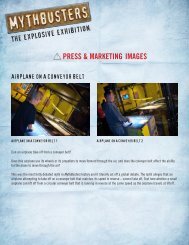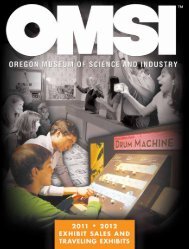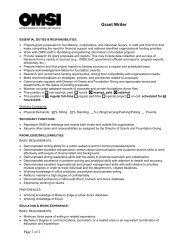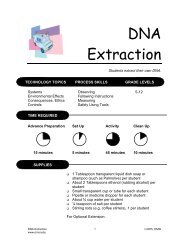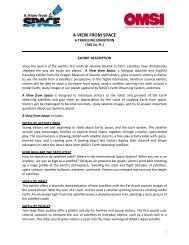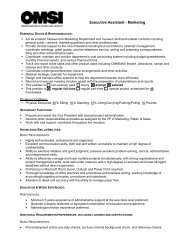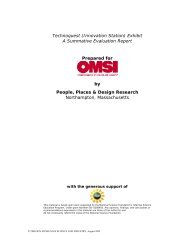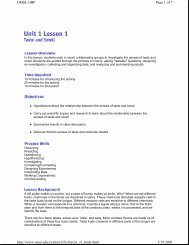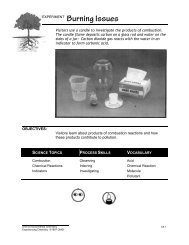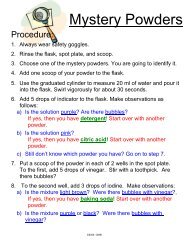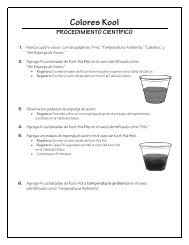ADRENALINE RUSH: THE SCIENCE OF RISK - Big Movie Zone
ADRENALINE RUSH: THE SCIENCE OF RISK - Big Movie Zone
ADRENALINE RUSH: THE SCIENCE OF RISK - Big Movie Zone
Create successful ePaper yourself
Turn your PDF publications into a flip-book with our unique Google optimized e-Paper software.
<strong>ADRENALINE</strong> <strong>RUSH</strong>: <strong>THE</strong> <strong>SCIENCE</strong> <strong>OF</strong> <strong>RISK</strong><br />
An Experiment: The Egg Drop<br />
To Do:<br />
An excellent way to test aerodynamic principles is to build a<br />
(small) working parachute. Using it to drop an egg safely to the<br />
ground is an excellent way to see how well it works. Although<br />
you could use a relatively large version of Leonardo’s parachute,<br />
many other models can be used for the experiment.<br />
For a circular parachute, cut a large circle out of a plastic bag,<br />
or fabrics like cotton or nylon, with a small hole in the middle<br />
acting as a chimney. For a more challenging project, you can try<br />
to build a wing-shaped parachute, using light cardboard for the<br />
frame and paper or fabric for the wing’s surface. You can also<br />
create a net or a padded basket to carry the egg, change the<br />
number of strings, or try different lengths and types of string to<br />
tie the egg to the parachute, etc.<br />
The experiment can also be turned into a competition, with<br />
prizes for the lightest working parachute, the fastest safe drop,<br />
the longest drop, etc.<br />
Here are two web sites that provide useful<br />
instructions and tips:<br />
http://school.discovery.com/<br />
lessonplans/programs/forcesandmotion/<br />
A page by the Discovery Channel shows<br />
how to test various sizes of parachutes,<br />
always with the goal of dropping the egg to<br />
the ground without it breaking.<br />
http://college.hmco.com/<br />
education/pbl/project/project3.html<br />
Another page on possible ways to drop the<br />
egg safely, by publisher Houghton Mifflin.<br />
NASA<br />
to the Rescue<br />
NASA’s John H. Glenn<br />
Research Center in Cleveland,<br />
Ohio, has published an online<br />
Beginner’s Guide to<br />
Aeronautics, featuring dozens<br />
of activities for elementary,<br />
middle and secondary school<br />
students which were<br />
designed by teachers from all<br />
over America.<br />
Beginner’s Guide to Aeronautics<br />
home page<br />
http://www.grc.nasa.gov/W<br />
WW/K-12/airplane/<br />
Activities home page<br />
http://www.grc.nasa.gov/WW<br />
W/K12/TRC/Aeronautics/Aero<br />
nauticActivitiesHome2.htm<br />
Discussing<br />
Aerodynamics and Parachutes:<br />
Here are a few questions that can also help you<br />
discuss the principles of aerodynamics and the uses of parachutes:<br />
1. Would a parachute work in space? Why?<br />
2. Beyond human jumps, what are parachutes also used for?<br />
3. Why can’t a parachute work without someone<br />
or something suspended to it?<br />
4. What other force makes flying a plane different,<br />
in terms of aerodynamics, from flying a parachute,<br />
a kite or a glider?<br />
5. Even though cars don’t fly, aerodynamics<br />
play an important part in their design. Why?<br />
(Answers on page 17)<br />
15<br />
Answers from page 17:<br />
1-H, 2-J, 3-G, 4-F, 5-I, 6-A, 7-B, 8-D, 9-E, 10-C



